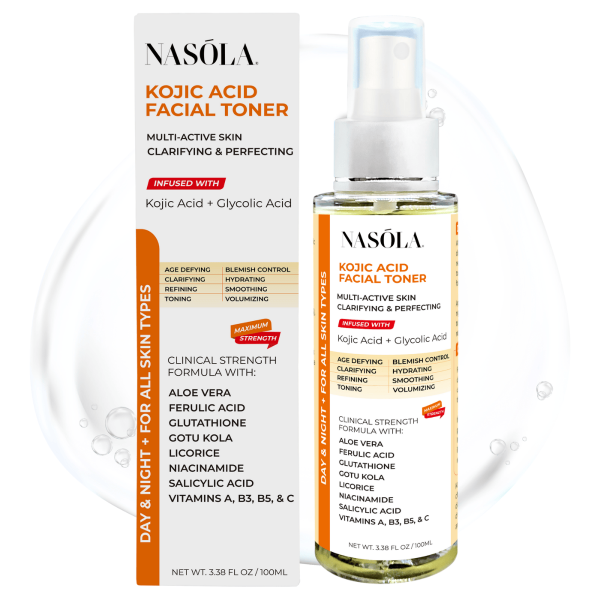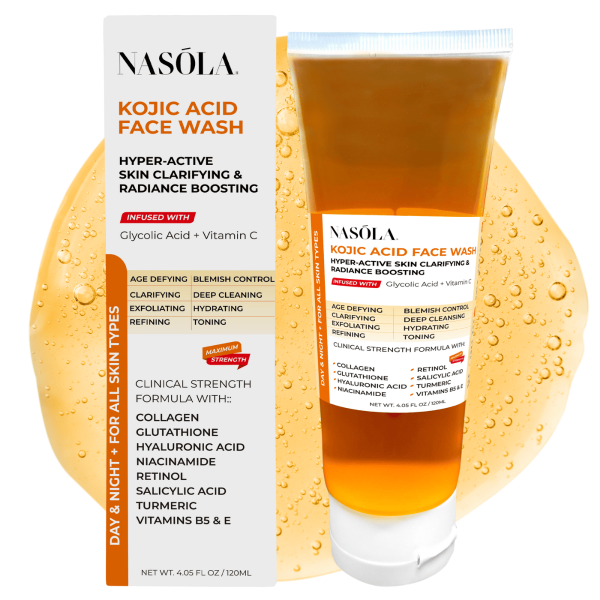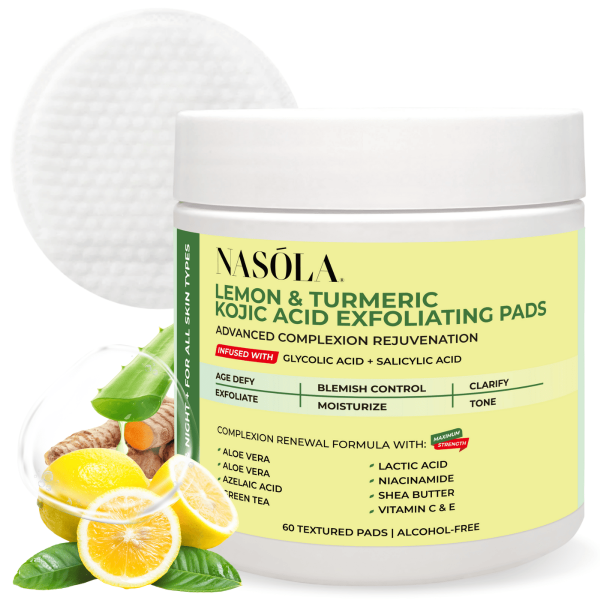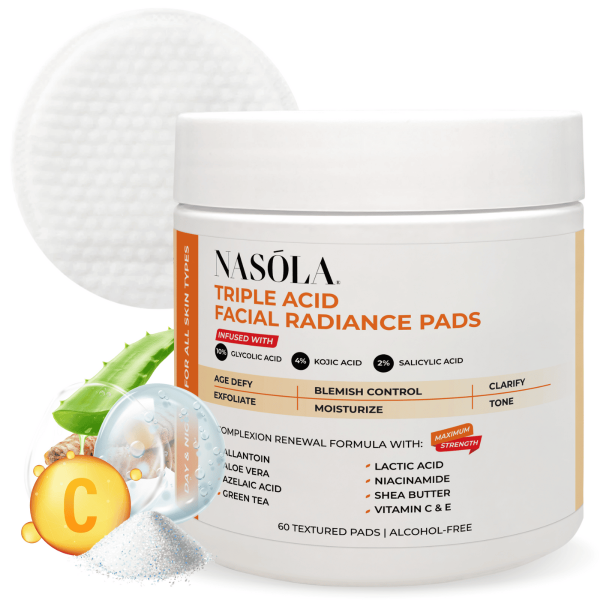If you’ve ever stood in the skincare aisle—or spent a few too many late-night hours reading ingredient labels online—you’ve probably asked yourself this: azelaic acid vs salicylic acid, what’s the real difference?? 🤔
Should you be using one, both, or neither??? That’s where the confusion kicks in.
Both ingredients have mega reputations for treating acne, hyperpigmentation, dark spots, and yes—those sneaky blackheads that always seem to pop up days before something important.
But don’t worry… you’re not expected to figure it all out alone.
Today we’re breaking it ALL down.
By the end of this, you’ll know exactly which acid fits your face like a tailored silk glove—and, just in case you’re like me and obsessed with glow-ups, we’ll show you how to slip them into your rhythm gently (and effectively!).
Oh, and if you’re all about fast results that don’t come with stinging regret? 👀 You’ll love hearing about gems like Nasola Triple Acid Facial Radiance Pads and the gorgeous Nasola Kojic Acid Facial Toner.
You’ll see why!
- Understanding the Differences Between Azelaic Acid and Salicylic Acid
- Can I Use Azelaic Acid and Salicylic Acid Together?
- Salicylic Acid vs Azelaic Acid: Which One Should You Choose?
- Azelaic Acid vs Salicylic Acid for Acne
- Azelaic Acid vs Salicylic Acid for Blackheads
- Ingredient Focus: Kojic Acid for Skin Brightening
- Conclusion
- Frequently Asked Questions
Understanding the Differences Between Azelaic Acid and Salicylic Acid
Let’s take the guesswork out of which acid is doing what on your skin—and why it matters. In this comparison of salicylic acid vs azelaic acid, understanding their origin and function is key to noticing real glow-ups.
Trust me, it’s not about choosing “team acid”… it’s about knowing who plays well with your skin’s vibe.
What Is Azelaic Acid and How Does It Work?
Azelaic acid is like the quiet multitasker in your skincare circle. Derived from grains like barley and wheat, it’s a dicarboxylic acid (yes, fancy, but gentle).
- It reduces inflammation and kills acne-triggering bacteria
- Gently unclogs pores while fading post-acne marks
- Ideal for rosacea, sensitive, or redness-prone skin
- Lightens pigmentation caused by acne, sun or melasma
Unlike exfoliants, it doesn’t peel your skin—it teaches it to act right. This makes it an MVP for those who’ve been burned (literally) by harsher actives.
What Is Salicylic Acid and How Does It Work?
Now, salicylic acid? That bold BHA walks into the party and clears the dancefloor (a.k.a. your pores). It’s oil-soluble, which lets it dive deep into the pores where blackheads and freak-outs live.
- Targets blackheads, whiteheads, and oily acne-prone areas
- Penetrates deep to break apart gunk inside pores
- Reduces excess oil production
- Helps improve skin texture with regular use
Need to exfoliate, de-gunk, and polish your glow? This is it. But it’s not always best for dry or super-sensitive skin. Choose wisely.
Can I Use Azelaic Acid and Salicylic Acid Together?
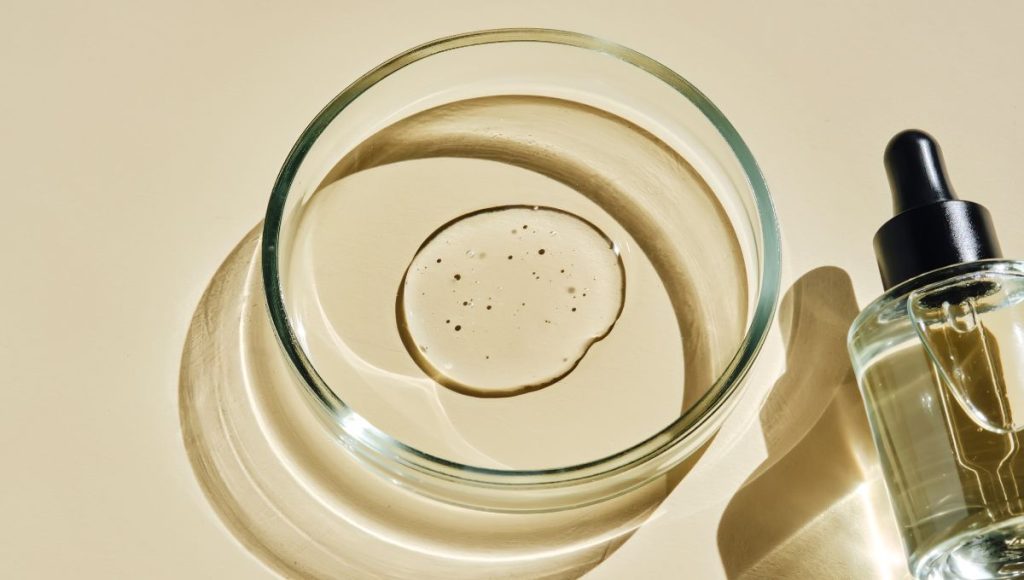
Short answer: Yes, you can—but like mixing wine and dessert, timing matters.
Using these two powerhouses side by side can help tackle both inflammation and congestion—which is magic for textured, acne-prone skin.
Tips for Combining Both Safely
The trick is introducing salicylic and azelaic acid gradually. Skin likes balance, not chaos:
- Alternate mornings and evenings (ex: azelaic at night, salicylic in the AM)
- Use salicylic 2–3x per week, especially if you’re dry or new to acids
- Always moisturize afterward and use sunscreen in the daytime
- Watch for signs of irritation—peeling, redness or burning means back off
Want a foolproof starter? The Nasola Triple Acid Facial Radiance Pads give you salicylic acid alongside glycolic and lactic acids.
Bonus?
They’re wrapped in botanicals that soothe while they clarify—making them a perfect match for azelaic acid without overwhelming your skin.
When Should You Avoid Using Them Together?
You know your skin best… but some signals deserve attention:
- Red, damaged, or freshly exfoliated skin? Don’t layer them.
- Skin already on retinol or prescription treatments? Proceed. very. carefully.
- Experiencing stinging or flaking? Alternate days instead.
Always patch test, ease in slowly—and support your skin barrier with nourishing toners like the Nasola Kojic Acid Facial Toner. It hydrates while brightening, which is the perfect wingperson when using actives.
Salicylic Acid vs Azelaic Acid: Which One Should You Choose?
Ahh, decision time. You know how every skin has its own mood? Well, so do actives. Whether you go for azelaic acid vs salicylic acid, that call depends on YOUR skin goals.
Choose Based on Your Skin Type
Let this be your cheat sheet:
- Oily or acne-prone skin? –> salicylic acid
- Dry, reactive or rosacea-prone skin? –> azelaic acid
- Pigmentation + breakouts? –> combo of both!
- Clogged pores and hormonal acne? –> salicylic acid first, azelaic to calm remnants
Want something that respects your sensitive side and brightens effortlessly? The Nasola Kojic Acid Facial Toner delivers tone-evening magic with zero sting.
Paired with salicylic or azelaic acids, it levels up your clarity without the crash-and-burn some products bring.
Niacinamide for Enhanced Soothing
Niacinamide is the unsung hero that plays peacemaker. If you’re blending actives, make sure there’s room for this multitasker:
- Calms redness, irritation and restores skin barrier
- Works with both azelaic AND salicylic acid
- Minimizes pores and boosts glow
- Perfect for sensitive skin transitions
Look for serums with niacinamide to layer between steps—or pair your acids with niacinamide-infused moisturizers.
Azelaic Acid vs Salicylic Acid for Acne
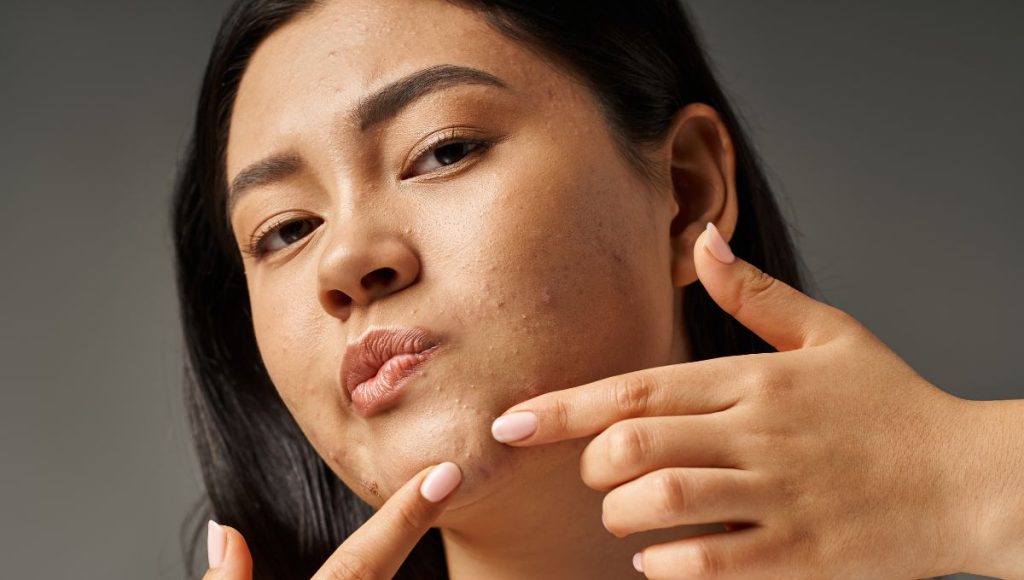
Let’s cut to the comparison: azelaic acid vs salicylic acid for acne. They’re both heavy hitters—but they fight different enemies on the skin battleground.
How Azelaic Acid Helps Acne
Think of Azelaic Acid as your inflammation whisperer. If your acne looks red, feels angry, or leaves dark reminders behind (ugh, post-acne hyperpigmentation), azelaic acid can save the day:
- Decreases inflammation from deep acne
- Lightens leftover spots from trauma or picking 😬
- Works on fungal acne too!
- Minimizes discoloration and soothes simultaneously
It won’t decongest as fast—but it builds clarity slow and steady.
How Salicylic Acid Tackles Breakouts
This one likes to get in there—pore deep. Here’s what it does best:
- Dissolves trapped oil and dead skin cells
- Unclogs existing pimples and blackheads
- Reduces oily shine and congested T-zone
- Prevents future breakouts with consistent use
Struggling with both active acne and scars?
Double down with the Nasola Lemon Turmeric Kojic Acid Exfoliating Pads. You’ll get antioxidant turmeric, brightening kojic acid, and gentle exfoliation to renew—without irritation.
Azelaic Acid vs Salicylic Acid for Blackheads
Okay, blackheads. The tiny beasts that haunt our noses (and sometimes chin and forehead). If you’re asking who wins the battle of azelaic acid vs salicylic acid blackheads, here’s the honest scoop.
Why Salicylic Acid Wins for Blackheads
This acid doesn’t just dissolve oil—it slips past it and lives there. It:
- Clears existing blackheads and prevents more
- Breaks down buildup inside pores fast
- Helps reduce sebaceous filaments
- Tightens pore appearance over time
It’s the go-to for recurring congestion and oily flare-ups.
How Azelaic Acid Helps Maintain Clear Pores
Honestly? It’s the aftercare king. Azelaic keeps your skin calm and bacteria at bay, so fewer blackheads form over time:
- Antimicrobial protection = reduced clogged pores
- Gentle enough for daily use
- Ideal for blackhead-prone but reactive skin
- Can be used near sensitive zones
Want to pre-cleanse like a skincare boss? Start with the Nasola Kojic Acid Face Wash. It lifts oil and impurities with zero strip—and leaves skin supple, prepped and ready for actives to follow.
Ingredient Focus: Kojic Acid for Skin Brightening
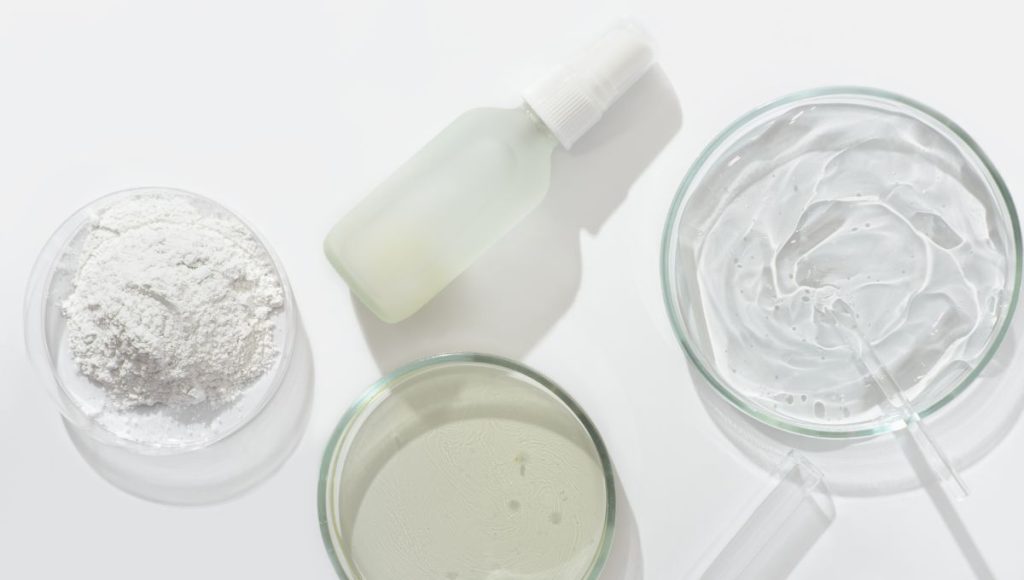
Let’s take a glow detour. Kojic acid deserves a spotlight—because no matter which acid you choose, brightening is always welcome. ✨
Kojic acid is a pigment-inhibitor powerhouse that evens tone without bleachy drama. It plays nicely with azelaic and salicylic acid—meaning more radiant results faster.
- Reduces appearance of sunspots, age spots, and melasma
- Tackles post-inflammatory hyperpigmentation (PIH)
- Boosts overall brightness and light reflection
- Derived naturally from fermented rice or fungi
Every Nasola formula incorporates kojic acid in some way:
- Nasola Kojic Acid Facial Toner for soothing and brightening in one
- Nasola Kojic Acid Face Wash for a gentle, nourishing cleanse
- Nasola Lemon Turmeric Kojic Acid Exfoliating Pads for targeting scars and active pimples in one smooth swipe
Layering kojic acid into your routine lets your acids do MORE—with less irritation. You glow quicker, without looking peeled and dry.
Conclusion
When it comes to azelaic acid vs salicylic acid, there’s no wrong answer—only what your skin sings with. Azelaic is your calming, pigment-fading bestie.
Salicylic’s your go-to for blackheads, oil, and active breakouts.
The magic?
Knowing when, how, and with what to use them. That’s where Nasola shines. From gentle beginning like the Nasola Kojic Acid Facial Toner, to exfoliating saviors like Nasola Triple Acid Facial Radiance Pads, every product can be matched to your unique skin mood.
Want balance? Hydration? Or a total acne-fade transformation? Choose wisely—but boldly. Your skin will thank you for the kindness.
Frequently Asked Questions
Both work—but differently. Salicylic acid goes deep to clear clogs, making it best for recurring blackheads and oily acne. Azelaic acid calms redness and fades hyperpigmentation. The winning choice? Using both methodically for layered acne care.
Absolutely. It’s one of the smartest ways to avoid irritation. Use azelaic in the AM (with your SPF!) and salicylic in the PM to exfoliate overnight. Keep your routine balanced and your skin barrier fed with calming steps in between.
Salicylic acid wins for clearing and preventing blackheads—its oil-soluble nature lets it dive into pores and break up debris. Azelaic helps the recovery phase by calming inflammation and reducing bacteria, preventing future pore blockages.
The Nasola Triple Acid Facial Radiance Pads have salicylic, glycolic, AND lactic acids—plus soothing botanicals and kojic acid to brighten. They’re the perfect exfoliant for smoother, clearer skin.
Yes—as long as your skin isn’t overly dry or irritated. The Nasola Kojic Acid Face Wash is gentle yet effective, helping remove oil and prep your skin before salicylic or azelaic acid without causing tightness or dryness.
Generally 4–6 weeks for active acne, and 8–12 weeks for dark spot fading. Consistency is key. Pair with gentle exfoliants like Nasola Lemon Turmeric Kojic Acid Exfoliating Pads to see even faster progress.
Definitely. The Nasola Kojic Acid Facial Toner layers beautifully over salicylic acid—giving hydration and brightening without irritating active skin. Just make sure to patch test first.
It can, if not balanced properly. To avoid this, combine them sneakily: use on different days or morning vs. evening. And add skin-loving hydrators and barrier supporters between them, like hyaluronic acid and niacinamide.
Yes, especially products like the Nasola Lemon Turmeric Kojic Acid Exfoliating Pads which include calming turmeric and kojic acid. Just test it first, and incorporate slowly into your routine.
YES! Acids make your skin more sensitive to the sun, so daily SPF is non-negotiable. It protects your glow and prevents further damage—which is kinda the point, right?


